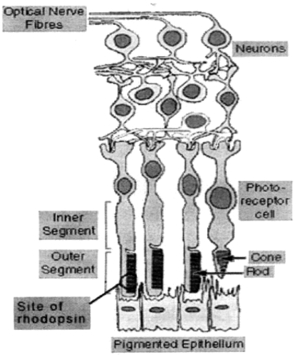 | Fig. 41: In the eye, light enters the pupil, is focused and inverted by the cornea and lens, and then is projected onto the retina at the back of the eye. The retina consists of several layers of cells, shown above. The only light-sensitive step during vision takes place in the outer segment of photoreceptor cells, and is catalyzed by the molecule rhodopsin. Light causes rhodopsin to change shape, which then triggers a signal to be sent through the layers of cells that make up the retina, resulting in a neural signal to the brain. (Adapted from Gebhard Schertler's web page, MRC-LMB, Cambridge, UK, with permission). |
The function of our eyes is to allow us to see the objects in our surroundings or variable distances and under various conditions of lights. This function is achieved by a very complex arrangement of layers and structures found in the eye. In addition, two pockets of transparent fluid—the aqeous and vitreous humors—nourish eye tissues and help maintain constant eye shape.
With the recent advances in molecular genetic techniques, new genes that cause eye disease are rapidly being identified, such as for those diseases discussed here. In many instances, these findings allow researchers to develop innovative stergies for preventing or slowing down the progress of genetic diseases of eyes.
 Prof. Dr. Sohan Raj Tater
Prof. Dr. Sohan Raj Tater
 Doctoral Thesis, JVBU
Doctoral Thesis, JVBU